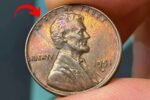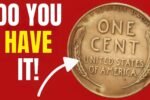In the fascinating realm of coin collecting, there are few things more exciting than the possibility that a seemingly ordinary coin might be worth a small fortune. Among the many coins that have captured public imagination, one particular story has taken on a life of its own—the legend of the Rare Bicentennial Quarter supposedly valued at an unbelievable $2.5 billion and rumored to still be floating around in everyday circulation. This tale has been the subject of countless online articles, videos, and social media debates. While the extraordinary valuation might sound too good to be true—and, indeed, it likely is—the myth continues to enthrall collectors and casual hobbyists alike.
This article aims to separate fact from fiction, offering a detailed look at the origins of this unbelievable story, the truth behind it, and what coin enthusiasts should genuinely be looking out for when it comes to the Rare Bicentennial Quarter.
The Roosevelt Dime Valued at $12.7 Million, Still in Circulation
A Deep Dive into the Bicentennial Quarter
To understand why the Rare Bicentennial Quarter is such a hot topic, it’s important to first recognize its historical significance. The United States Mint introduced the Bicentennial quarter as part of the nation’s celebration of 200 years of independence. These coins were minted in 1975 and 1976 and were unlike any other quarters in circulation at the time.
Rather than the standard reverse design featuring an eagle, the Bicentennial quarter displayed a special patriotic image created by artist Jack L. Ahr. The design showcases a Colonial drummer in uniform beside a victory torch encircled by thirteen stars—representing the original colonies. On the obverse, the iconic image of George Washington remains unchanged, but the date “1776–1976” replaces the usual single year of minting.
Over 1.6 billion Bicentennial quarters were struck across three mints—Philadelphia (no mint mark), Denver (D), and San Francisco (S). Because of this enormous mintage, the vast majority of these coins are incredibly common today, often found in pocket change, coin jars, and even car cupholders. For most people, the Rare Bicentennial Quarter is just another piece of change. But some versions, as we’ll see, are far from ordinary.
The Outlandish $2.5 Billion Valuation
The root of the $2.5 billion valuation appears to come from a viral social media claim. Posts and videos circulating across platforms such as TikTok, Facebook, and YouTube suggest that a Rare Bicentennial Quarter with a dramatic minting error or unique alloy composition could command a price tag of $2.5 billion. Some versions of the story allege that this coin was a prototype minted at the San Francisco Mint with an experimental metal, while others imply it was struck in error on a wrong planchet, possibly one used for a foreign coin.
Despite the excitement such claims stir, there has been no credible confirmation of the existence of such a coin by any major numismatic authority, auction house, or grading service. No listing exists in the catalogs of trusted auctioneers such as Heritage Auctions or Stack’s Bowers that even remotely approach such an astronomical figure. To date, the most expensive U.S. coin ever sold is the 1933 Double Eagle, which fetched just over $18 million in 2021—nowhere close to the $2.5 billion figure being thrown around.
Why the Billion-Dollar Quarter Is a Myth
It’s essential to remember that in numismatics, value is driven by a combination of rarity, condition, historical significance, demand, and provenance. Even the rarest coins in U.S. history—like the 1794 Flowing Hair Silver Dollar or the aforementioned 1933 Double Eagle—derive their multi-million-dollar values from these attributes, and not from social media hype.
The story of a Rare Bicentennial Quarter worth $2.5 billion doesn’t hold up under scrutiny. First, there’s no confirmed example of such a coin in any private or institutional collection. Second, the idea that a coin with no traceable auction history or grading record could instantly be worth more than any verified numismatic treasure is implausible at best. The legend may make for a thrilling tale, but it has no grounding in numismatic fact.
Real Examples of Rare Bicentennial Quarters
That said, it would be a mistake to dismiss the entire Bicentennial quarter series as worthless. There are authentic, Rare Bicentennial Quarter variations that command impressive prices—just not in the billions.
Here are a few notable examples:
-
40% Silver Bicentennial Quarters: Produced primarily for collectors, these were minted in San Francisco as part of special proof and uncirculated sets. These silver-clad coins contain 40% silver and can fetch between $5 and $20 depending on their condition and whether they remain in their original packaging.
-
Error Coins: A 1976 Bicentennial quarter struck on a dime planchet sold for $12,000 in 2021. Such errors are extremely rare but are eagerly sought after by collectors. Other errors to look for include off-center strikes, doubled dies, and incorrect planchet compositions.
-
High-Grade Specimens: A standard Bicentennial quarter in pristine, uncirculated condition graded MS-67 or higher by PCGS or NGC can command hundreds or even thousands of dollars at auction.
How to Spot a Rare Bicentennial Quarter
For those interested in joining the search for valuable coins, here are some practical tips to identify a potentially Rare Bicentennial Quarter:
-
Mint Mark Identification: Quarters with an “S” mint mark are likely proof or silver issues. These are worth checking carefully, especially if they appear in change, which is uncommon.
-
Unusual Coloration or Weight: If the coin has a different hue or feels lighter/heavier than a regular quarter, it may be struck on an incorrect planchet—an error that can be quite valuable.
-
Die Errors: Look closely for doubling of letters or design features, known as doubled dies. These varieties are highly collectible and often overlooked.
-
Exceptional Condition: Coins with no visible wear, strong luster, and sharp design elements are more desirable. Consider having such coins graded by a professional third-party service.
The Allure of Coin Collecting
The enduring appeal of the Rare Bicentennial Quarter story—even as a myth—says a lot about human nature. The idea that a simple coin you might receive in change could be worth a fortune taps into a sense of mystery, wonder, and the thrill of hidden treasure. Even though a $2.5 billion quarter likely doesn’t exist, the passion and excitement surrounding the search for valuable coins remain very real.
Numismatics is a hobby where education pays off. While internet rumors should be taken with a healthy dose of skepticism, the rewards for those who take the time to learn about mint marks, die varieties, and grading can be substantial.
Final Thoughts: Reality Over Rumor
The legend of the Rare Bicentennial Quarter allegedly worth $2.5 billion is just that—a legend. It’s a colorful story, one that stirs the imagination and encourages treasure hunts through piles of pocket change. But in the world of professional coin collecting, verifiable proof is everything. There is no documented, authenticated, or graded example of such a coin existing, let alone being sold for billions.
However, there are Rare Bicentennial Quarter examples out there that are truly worth money. Proof coins, minting errors, and high-grade specimens offer real value to collectors. And that’s the real takeaway: while myths may fade, the joy of discovery and the potential for finding a hidden gem in your spare change will always remain part of what makes coin collecting such a rewarding pursuit.
FAQ: The Rare Bicentennial Quarter Valued at $2.5 Billion, Still in Circulation
Q1: Is there really a Rare Bicentennial Quarter worth $2.5 billion?
No, there is no verified or authenticated Rare Bicentennial Quarter worth $2.5 billion. This story likely originated from online hoaxes or misinterpreted information and has no basis in professional numismatics.
Q2: What is a Bicentennial quarter and why is it special?
The Bicentennial quarter was issued in 1975 and 1976 to commemorate America’s 200th birthday. It features a unique reverse design of a Colonial drummer and the dual date “1776–1976,” making it different from standard Washington quarters.
Q3: Are any Bicentennial quarters actually valuable?
Yes, several types of Rare Bicentennial Quarters are indeed valuable. These include silver-clad proofs, error coins, and high-grade uncirculated examples. Some have sold for thousands of dollars at auction.
Q4: Should I bother checking my spare change for rare coins?
Absolutely. While you won’t likely find a coin worth billions, you might come across a valuable Rare Bicentennial Quarter or other collectible coin that could be worth significantly more than face value. It’s always worth taking a closer look.
Some Important Link
| Telegram Group | Click Here |
| WhatsApp Group | Click Here |
| Home Page | Click Here |














